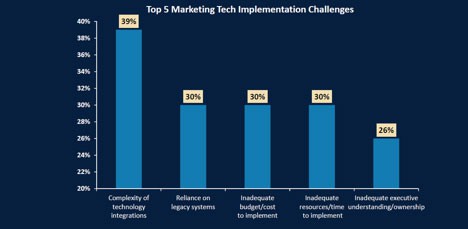In Morgan Stanley’s recent ‘Software Eats the CMO Suite’ survey, the number one business to business challenge for Chief Marketing Officers with their technology purchases is the inability to successfully integrate disparate technologies into a unified platform. This integration issue is also a consistent one we see across our enterprise client base and through informal polling of my professional network – the end result is a disjointed customer experience and an incomplete way to identify what marketing tactics are driving true sales/business results.

As a root cause of the issue, in larger enterprises, these platforms run cross organization – for example, internal IT ‘owns’ the data warehouse, whereas Marketing owns Marketing Automation. This ownership rift exacerbates the challenge of bringing disparate systems together with no one organization owning the integration aspect of systems like these.
There are at least two symptoms of the root cause of not being able to integrate platforms:
- The inability to have a seamless customer journey so that the journey is one experience, not several disjointed automated experiences. We find this to be the fundamental driver of customer success.
- Non-reportable, non-actionable data. Can’t correctly answer the question ‘what demand generation / online sales techniques are most effective with disparate islands of data?’ This situation is a sharp pain point for ANY CMO trying to attribute their performance to revenue.
So how does a CMO solve this complex integration situation in 2017? The integrated technology strategy CMOs should involve the following factors:
- Start with the end in mind – determine ‘what are you hoping to accomplish with an integrated strategy that drives the right customer experience?’ Get others in the organization to buy into that approach and assign a business owner to the process. This step is sometimes referred to as a ‘needs assessment’.
- Select the initial automation platform wisely and not hastily. A specific marketing automation choice dictates a significant part of your go to market strategy and your ability to integrate with partners to drive a seamless customer experience. Switching costs out of platforms are expensive and time consuming. Invest time in really understanding the partner ecosystem and/or hire someone who has that understanding, else risk wasting valuable time.
- Understand API capabilities on your chosen marketing automation platform – leveraging APIs is the ‘mortar between the data bricks’. There is a radical difference across each REST API of automation platforms. Some platforms will charge extra for use of the APIs. Be mindful or find a trusted partner who has done these kinds of integrations before as API work is often times non-core to the business.
As a B2B enterprise, what issues are you experiencing in cross platform integration? What platforms do you most effective to automate your customer experience? Would love to hear your comments!
 Today’s blog contribution comes from Jon Russo, founder of B2B Fusion, a sales and marketing performance firm focused on connecting marketing investment to new revenue. Enterprise clients include Anthem, Ricoh, Thomson Reuters, and Level 3 among others. Jon currently serves on the Board of Directors for MOCCA, the leading enterprise association for operational excellence in Digital Marketing. Prior to founding B2B Fusion, Jon held global CMO roles for 10 years in private and public technology companies in Silicon Valley, NYC, and Luxembourg.
Today’s blog contribution comes from Jon Russo, founder of B2B Fusion, a sales and marketing performance firm focused on connecting marketing investment to new revenue. Enterprise clients include Anthem, Ricoh, Thomson Reuters, and Level 3 among others. Jon currently serves on the Board of Directors for MOCCA, the leading enterprise association for operational excellence in Digital Marketing. Prior to founding B2B Fusion, Jon held global CMO roles for 10 years in private and public technology companies in Silicon Valley, NYC, and Luxembourg.
